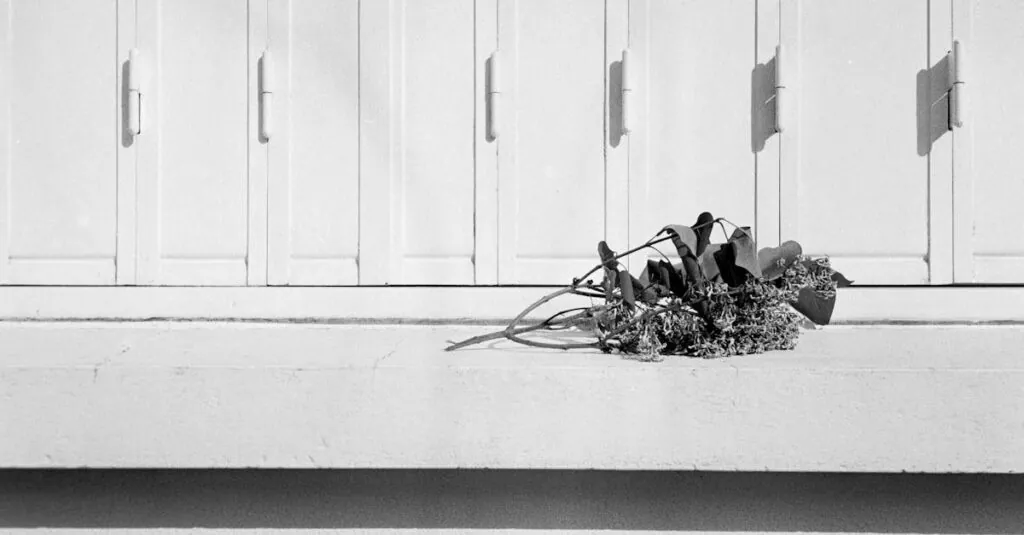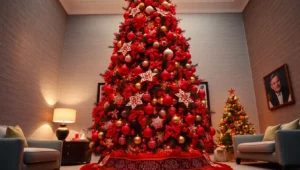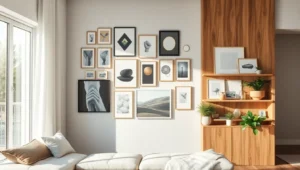Imagine stepping into a home that feels like a cozy time capsule, where every corner whispers stories of the past. Vintage home decor isn’t just a trend; it’s a lifestyle choice that adds character and charm to any space. With the right tips, anyone can transform their living area into a nostalgic haven that even their grandmother would approve of—minus the cat hair.
Table of Contents
ToggleUnderstanding Vintage Home Decor
Vintage home decor showcases unique aesthetics that bring nostalgia to modern living spaces. It combines styles from various past eras, creating a sense of character and charm.
What Defines Vintage Style?
Vintage style consists of items that are typically at least 20 years old, often reflecting the design trends of their time. Collecting unique pieces enhances authenticity and creates a cohesive look. Materials like wood, metal, and fabric each contribute to the vintage feel, adding warmth and texture. Color palettes often incorporate muted tones, pastel shades, or earthy hues. Key elements include antique furniture, retro textiles, and vintage-inspired artwork. Mixing these components allows for personal expression while honoring the charm of the past.
The Appeal of Vintage Aesthetics
Vintage aesthetics resonate emotionally, evoking fond memories and a sense of nostalgia. Timeless designs often capture the essence of craftsmanship, showcasing quality over quantity. Elements like intricate patterns or handcrafted details stand out in vintage decor. Incorporating vintage pieces fosters a warm, inviting atmosphere, promoting comfort. The uniqueness of each vintage item ensures individuality, as no two collections look alike. Blending vintage elements with contemporary decor allows homeowners to create a dynamic and visually engaging environment.
Key Elements of Vintage Home Decor
Vintage home decor combines distinctive pieces that capture the essence of earlier eras. Elements such as furniture, color palettes, and accessories contribute significantly to the nostalgic atmosphere.
Furniture Choices
Selecting the right furniture anchors a vintage decor scheme. Antique pieces add character, while mid-century modern designs complement contemporary elements. A combination of ornate tables, plush armchairs, and vintage sofas creates an inviting space. Restoration or refinishing can breathe new life into older furnishings, preserving their charm. Prioritizing quality wood, metal, and fabric enhances texture and warmth, essential traits of vintage decor.
Color Palettes
Muted tones define the color palettes favored in vintage decor. Pastel shades evoke softness, while earthy hues promote a sense of tranquility. Accent walls painted in gentle colors enhance the overall ambiance. Pairing these colors with vibrant vintage pieces adds visual interest. Utilizing textured wallpaper or vintage-inspired patterns can further elevate the aesthetic and cultivate a nostalgic feel.
Accessorizing with Vintage Finds
Accessorizing enhances the vintage theme in any space. Incorporate unique items such as old clocks, vintage mirrors, and retro lighting to add charm. Textiles like lace curtains or floral-patterned throws soften interiors. Grouping collections of vintage books or porcelain adds character to shelving. Each accessory contributes to storytelling, allowing personal memories to blend seamlessly within the decor.
Popular Vintage Decor Styles
Vintage decor encompasses various styles, each with unique characteristics and appeal. Understanding these styles helps in curating a nostalgic atmosphere.
Mid-Century Modern
Mid-century modern decor features clean lines and organic shapes. Furniture from this era often uses natural materials like wood and leather, creating warmth. Iconic pieces, such as Eames chairs and teak cabinets, add sophistication. Colors like olive green and mustard yellow often play a crucial role in the palette. Accessories include abstract wall art and geometric patterns that enhance visual interest.
Shabby Chic
Shabby chic decor showcases a romantic, soft aesthetic. This style emphasizes distressed furniture, often painted in pastel colors. Floral fabrics and vintage lace offer texture and charm. Items like mismatched china and antique mirrors contribute to the cozy, lived-in feel. Soft lighting, through chandeliers or vintage lamps, adds warmth, making spaces inviting and comfortable.
Industrial Vintage
Industrial vintage blends raw, utilitarian elements with a warm, inviting atmosphere. Exposed brick walls, metal fixtures, and reclaimed wood define this style. Furniture often features a combination of metal and wood, creating a striking contrast. Lighting, such as Edison bulbs or factory-style lamps, adds character. Artwork often includes vintage signage or abstract pieces to complete the look.
Tips for Incorporating Vintage Decor
Incorporating vintage decor can transform a living space into a charming and inviting home.
Mixing Vintage with Modern Elements
Combining vintage finds with modern pieces creates a balanced aesthetic. Select statement items, like a retro coffee table or mid-century chair, to showcase vintage character. Match them with contemporary furniture to give a fresh feel. Using modern art alongside antique frames adds visual interest, creating a unique focal point. This blend highlights both styles while maintaining harmony in the décor.
Finding Authentic Pieces
Searching for authentic vintage items enhances the overall aesthetic. Visit local flea markets, estate sales, or antique shops for unique treasures. Online marketplaces like Etsy and eBay often feature vintage pieces from various decades. When purchasing, assess the item’s condition and history to ensure authenticity. This investment not only adds character but also a sense of history to the space.
DIY Vintage Decor Projects
Engaging in DIY projects allows personalization of vintage decor. Repurposing old furniture, such as transforming a wooden ladder into a bookshelf, provides functionality and charm. Painting or distressing pieces can create a vintage look tailored to individual taste. Crafting accessories like vintage-style pillow covers or wall art can also enhance the décor. Such projects encourage creativity while reinforcing the vintage theme throughout the home.
Conclusion
Embracing vintage home decor offers a unique way to infuse character and warmth into any living space. By thoughtfully selecting pieces that resonate with personal style and history, homeowners can create an inviting atmosphere that tells a story. Mixing vintage elements with contemporary designs not only enhances visual appeal but also reflects individuality.
With a focus on key aspects like furniture choices and color palettes, anyone can achieve a harmonious blend of nostalgia and modern comfort. Whether through thrift store finds or DIY projects, the journey of curating a vintage-inspired home is both rewarding and enriching. Ultimately, vintage decor is more than just aesthetics; it’s about creating a space that feels like home.





